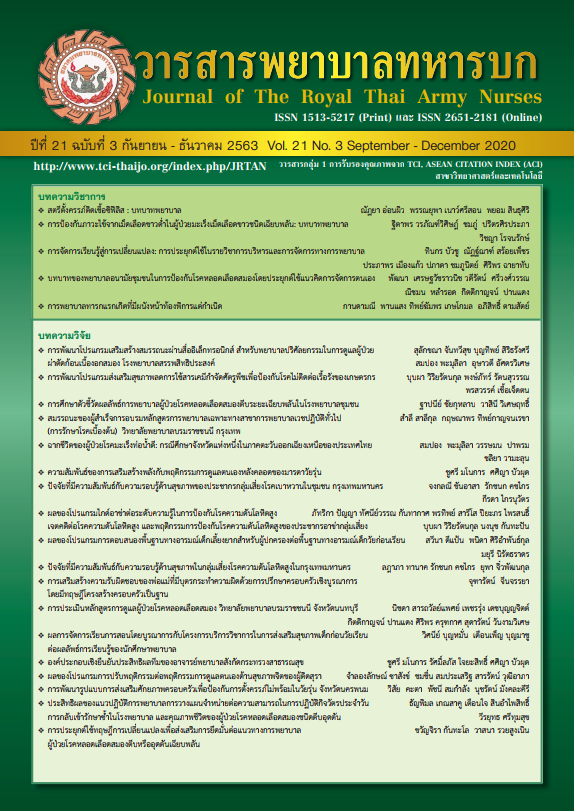Prevention of Febrile Neutropenia in Acute leukemia Patients: Role of Nurse
Keywords:
The role of nurse, Febrile neutropenia, Acute leukemiaAbstract
Acute leukemia is a disease caused by abnormalities of blood stem cells in the bone marrow. The chemotherapy is important drug which was used to destroy leukemic cells in acute leukemia patients. Febrile neutropenia is a serious complication of chemotherapy that is a major cause of death. S-SHIP-BE technique was used to prevention infection from febrile neutropenia. It comprised of screening, staff educating, hand hygiene washing, zoning, personal protective equipment wearing, bathing, and environment managing. These are important roles of nurse to promote the quality of life and they were effective techniques to reduce death rate in acute leukemia patients.
Downloads
References
Centers for Disease Control and Prevention. Blood cancers: leukemia, lymphoma, and a myeloma. 2013.
Siegel R, Naishadham D, Jemal A. Cancer statistics, 2013. CA Cancer J Clin 2013; 63(1):11-30.
Mayer DK, Travers D, Wyss A, Leak A, Waller A. Why do cancer patients visit emergency departments results of a 2008 population study in North Carolina. J Clin Oncol. 2011; 29(19):2683-8.
Leak A, Mayer D, Wyss A, Travers D, Waller A. Why do cancer patients die in the emergency department? An analysis of 283 deaths in NCEDs. Am J Hosp Palliat Care 2013;30(2): 178-82.
Freifeld AG, Bow EJ, Sepkowitz KA, Boeckh MJ, Ito JI, Mullen CA, et al. Executive summary: clinical practice guideline for the use of antimicrobial agents in neutropenic patients with cancer: 2010 Update by the infectious diseases society of America. Clin Infect Dis. 2011; 52:427-31.
Brandt B. Nursing protocol for the patient with neutropenia. Oncology Nursing Forum. 1990; 17 Suppl1:9-15.
Newburger PE, Dale DC. Evaluation and management of patients with isolated neutropenia. 2013;50(3):198-206.
Pizzo PA. Management of patients with fever and neutropenia through the arc of time: a narrative review. Ann Intern Med. 2019; 170(6):389-97.
Ariza-Heredia EJ, Roy F. Update on infection control practices in cancer hospitals J Cancer Clin. 2018; 68:340-55.
Itano J. In: Brant J, Conde F, Saria M. editors. Core curriculum for oncology nursing. 5. St. Louis, MO: Elsevier; 2015:262.
Freifeld A, Bow E, Sepkowitz K. Clinical practice guideline for the use of antimicrobial agents in neutropenic patients with cancer: 2010 update by the infectious diseases society of America. Clinic Infect Dis. 2011; 52:56-93.
Marrs JA. Care of patients with neutropenia. Clin J Oncol Nurs. 2006; 10(2):164-6.
National Comprehensive Cancer Network (NCCN) Clinical Practice Guideline in Oncology. Prevention and treatment of cancer-related infections, version 2.0. 2016.
Flowers C, Seidenfeld J, Bow E. Antimicrobial prophylaxis and outpatient management of fever and neutropenia in adults treated for malignancy. American society of clinical oncology clinical practice guideline. J Clin Oncol 2013; 31:794-810.
Putra BE, Tiah L. The mortality in emergency department sepsis score as a predictor of 1-month mortality among adult patients with sepsis: weighing the evidence. ISRN Emergency Medicine 2013; 2:1-6.
Abu El-Einein KM, Abd El-Mohsen Shaaheen E, Samy NI, Abd El-Hady Hammad NS. Efficacy of early goal-directed therapy in severe sepsis and septic shock. Menoufia Med J 2017;30: 971-7.
Penack O, Buchheidt D, Christopeit M. Management of sepsis in neutropenic patients: guidelines from the infectious disease working party of the German society of hematology and oncology. Ann Oncol. 2011; 22:1019-29.
Dellinger R, Levy M, Rhodes A. Surviving Sepsis Campaign: international guidelines for management of severe sepsis and septic shock: 2012. Crit Care Med. 2013; 41:580-637.
Milligan DW, Grimwade D. British committee for standards in haematology. Guidelines on the management of acute myeloid leukaemia in adults. Br J Haematol. 2003;135:450-74.
Creedle C, Leak A, Deal A. The impact of education on caregiver burden on two in patient oncology units. J Cancer Educ. 2012; 27(2):250–6.
Wall C, Glenn S, Poole H. Experiences prior to diagnosis of non-Hodgkin lymphoma: a phenomenological study. Journal of Advanced Nursing 2011;67(11):2363–72.
Klastersky J, Paesmans M, Rubensteinet EB, Boyer M, Elting L, Gallagher RF et al. The multinational association for supportive care in cancer risk index: a multinational scoring system for identifying low-risk febrile neutropenia cancer patients. J Clin Oncol 2016; 18: 3038-51.
Downloads
Published
How to Cite
Issue
Section
License
บทความหรือข้อคิดเห็นใดใดที่ปรากฏในวารสารพยาบาลทหารบกเป็นวรรณกรรมของผู้เขียน ซึ่งบรรณาธิการหรือสมาคมพยาบาลทหารบก ไม่จำเป็นต้องเห็นด้วย
บทความที่ได้รับการตีพิมพ์เป็นลิขสิทธิ์ของวารสารพยาบาลทหารบก
The ideas and opinions expressed in the Journal of The Royal Thai Army Nurses are those of the authors and not necessarily those
of the editor or Royal Thai Army Nurses Association.






